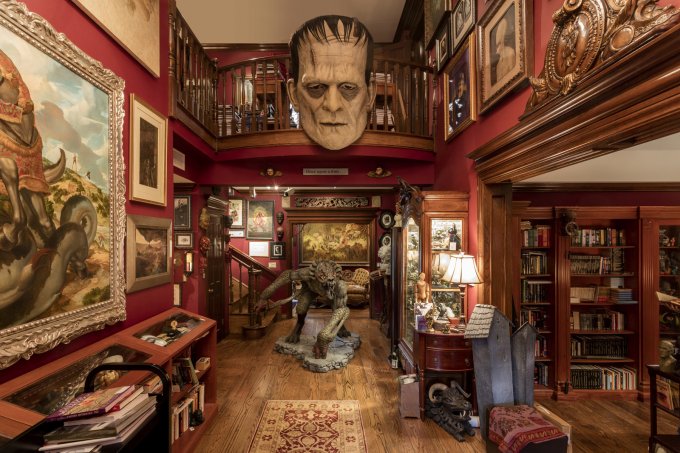Artists pursue the negative sublime - yet again.
It's elemental to confront the beast, the monster, the experience which no human life experience escapes.
 |
Foyer, Calabasas home called by Del Toro, "Bleak House"
I have not been a fan of the horror/goth genre, though noir is a fan niche. I tried to see "The Exorcist" in 1971, heavily pregnant, and ended up sitting out in the lobby, where I was chatted up by a fellow escapee.
I read lightly through the grisly descriptions and plots required in my favorite crime novel genre, and avoid some.
I do pride myself on owning a decent understanding of "the negative sublime", and the desensitization/sublimation defense mechanism, which I apply liberally like mental mosquito repellent at regular intervals.
Film is a powerful alchemy of cinematic tools which aestheticizes images of primal wounds and scenes, eroticizing shock and awe. The experience of physical pain and the resulting trauma is somehow demetasticized. I can then claim to possess a sanguine perspective that mostly remains in position as required by the goal of social adjustment.
|
 |
| personal notebook/journal |
I would have passed on the exhibit but for the request of my 10-year old grandson, a creature of surprising autonomy of interests and tastes. He saw the LACMA flyer at our house with an ad for this show and immediately asked to see it. We've pretty much done "Metropolis", Streetlights hide-and-seek,that green string maze, and he's too young to recline in Robert Irwin's mind-bending bathyscaph light show.
I'm quite glad I didn't. I would have missed an artist who tops out far and above the goth genre, working from Mexican literary/visual surrealism, the rich trove of cabinet-curiosity object-imagery, digital special effects and its possibilities, and iconic past horror films.
 |
| Max in background using interactive iPad display |
It's his granular, intense distillation of image that stuns. For instance, a clip of writhing octopus-like internal digestive organs, gave me a "made-you-look, grossed you out" moment. Winner! - the artist. Having sensory input is a valuable survival adaptation, but it does permit intrusion, violation. Bad smells, sounds. Experience, repeat. Efficient fight/flight mechanism in place. Thank the Creator for this.
Max took it all in, sometimes mildly amused.
The frightening black widow - I loved this dress.
 |
model of actual "freak" show performer Johnny Eck
model by Richard Kuebler
|
What the world made of him then, what he made of himself. He folded his lower body to create the appearance of having none. He walked on his hands before he was one year old. He appeared in a 1932 horror classic, "Freaks".
 |
Verisimilitude and unlike/like objects: Joseph Cornell and the movies blur existence.
The exhibit is very large, and I determined to watch del Toro's films, past and future. But I couldn't bring a die-hard or even medium fan familiarity to it and so I glazed over, sliding through the rooms zapping my eyeballs and observing what Max chose to look at. A perfect LA exhibition.
|
The week before I'd attended a presentation by Lesley Saar, daughter of iconic African-American artist Betye, age 90. In her own deeply personal way, she too responds to the divergent, macabre states of body and mind, delivered by an unkind fate, burdening the recipient with a hard road. Her son, born with autism spectrum, still living with the family at 24, is also transgender.
And she has lived the other, as a mulatto American born in 1953. Her work draws heavily from literary sources and depicts anthropomorphic, fantasy portraits of the singular individuals she perceives. I was reminded of the film, "The Elephant Man", with John Hurt, the one best film about the pain of bodily disfigurement I have ever seen.
 |
| Lesley Saar, "Cell Realization", 2014 |
The macabre goth horror genre is big right now. I have recently written about Rosamond Purcell, and I wouldn't want to exclude Cornelia Parker.
 |
Cornelia Parker, "Psychobarn", 2016 installation in the Metropolitan Museum of Art's Roof Garden
Parker is a British artist whose work is driven by the intuitive unconscious. This work is a mash of Edward Hopper and the house from "Psycho", rebuilt as a stage set from an old barn. Striking and haunting against the skyline, it's scaled to fit against it. A goth version of Main St. USA. Beautiful textures.
|










No comments:
Post a Comment